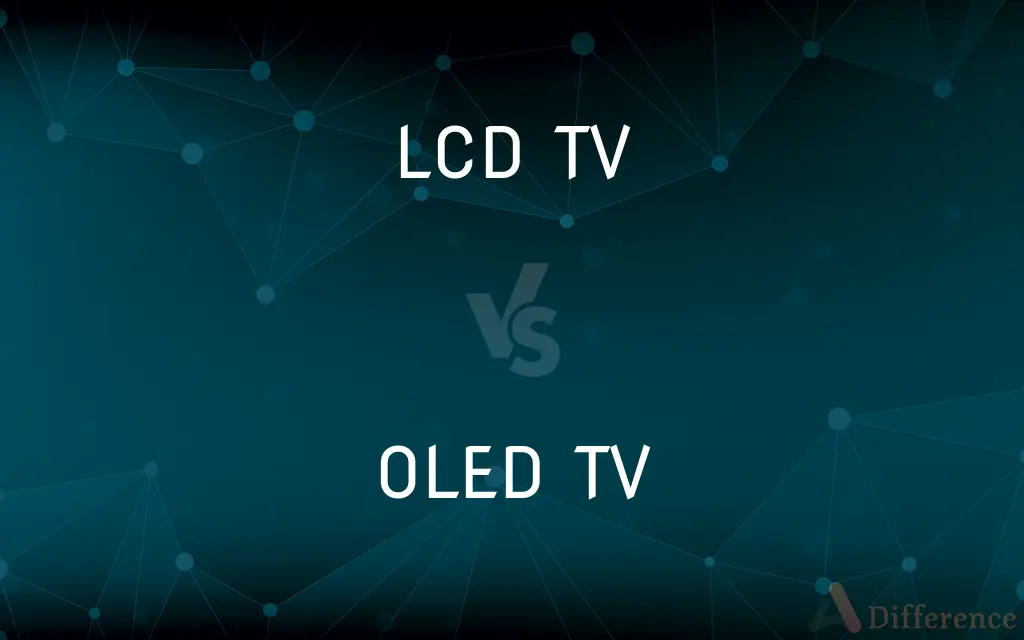LCD TV vs. OLED TV — What's the Difference?
By Tayyaba Rehman — Published on October 31, 2023
LCD TV uses a backlight to illuminate pixels and produce images, while OLED TV utilizes individual light-emitting cells, allowing for deeper blacks and better contrast.

Difference Between LCD TV and OLED TV
Table of Contents
ADVERTISEMENT
Key Differences
LCD TVs and OLED TVs represent two distinct technologies in the realm of display panels, each offering a unique set of advantages and disadvantages. LCD TVs utilize a backlight to illuminate pixels, allowing for the production of images on screen. This technology typically provides bright images with high resolution but can struggle with producing true blacks and maintaining color accuracy at wide viewing angles. LCD TVs are also generally more affordable and have a longer lifespan compared to OLED TVs, making them a popular choice among consumers.
OLED TVs, on the other hand, employ individual light-emitting cells, eliminating the need for a backlight. This technology enables each pixel to emit its light, allowing for the display of deeper blacks and superior contrast ratios compared to LCD TVs. Additionally, OLED TVs tend to have better color accuracy and wider viewing angles, providing a more immersive and vibrant viewing experience. However, they usually come with a higher price tag and are susceptible to burn-in over time, where static images can persist on screen.
In terms of thickness and design, OLED TVs generally have the upper hand, with the ability to be manufactured much thinner than LCD TVs. The absence of a backlight in OLED TVs contributes to their slim design, allowing for more flexibility and innovation in form factors, such as bendable or foldable screens. This slim and sleek design appeals to consumers looking for aesthetically pleasing and space-saving display solutions.
When it comes to energy consumption, LCD TVs tend to consume more power compared to OLED TVs when displaying dark images, as the backlight needs to be on, even when producing black colors. OLED TVs can be more energy-efficient in such scenarios as pixels can be turned off completely to produce black, consuming no power. However, when displaying bright and colorful images, OLED TVs might consume more power than LCD TVs.
In conclusion, while LCD TVs are a cost-effective solution offering bright and high-resolution images, OLED TVs excel in delivering exceptional contrast, color accuracy, and innovative designs, albeit at a higher cost.
ADVERTISEMENT
Comparison Chart
Display Technology
Uses a backlight to illuminate pixels
Utilizes individual light-emitting cells
Black Levels
Struggles with producing true blacks
Excels in displaying deep blacks
Thickness & Design
Generally thicker
Can be manufactured thinner
Price
More affordable
Higher price tag
Lifespan & Burn-in
Longer lifespan, no burn-in issues
Susceptible to burn-in, shorter lifespan
Compare with Definitions
LCD TV
Known for struggling with producing true blacks due to its backlight technology.
In darker scenes, LCD TV may not offer the depth of black seen in other display technologies.
OLED TV
Generally has a higher price tag and is susceptible to burn-in issues.
While offering premium viewing experience, OLED TV requires careful handling to avoid static image retention.
LCD TV
Tends to consume more power when displaying dark images as the backlight needs to be on.
LCD TV might not be the most energy-efficient option for watching movies with many dark scenes.
OLED TV
A television utilizing Organic Light-Emitting Diode technology, where each pixel emits its light.
OLED TV is renowned for its ability to display deep blacks and vibrant colors.
LCD TV
Typically has a longer lifespan and is not susceptible to burn-in.
For longevity, many consumers prefer LCD TV as it does not suffer from burn-in issues.
OLED TV
Can be manufactured much thinner and is capable of innovative designs like bendable screens.
The slim and sleek design of OLED TV makes it an aesthetically pleasing option for modern living rooms.
LCD TV
Generally thicker in design due to the necessity of a backlight.
The presence of a backlight in LCD TV results in a bulkier design compared to some alternatives.
OLED TV
More energy-efficient when displaying dark images as pixels can be turned off completely.
OLED TV can be a power-saving option for users who watch a lot of content with dark backgrounds.
LCD TV
A television utilizing Liquid Crystal Display technology and a backlight to produce images.
LCD TV is often chosen for its affordability and brightness in well-lit rooms.
OLED TV
Known for displaying superior contrast ratios and color accuracy compared to LCD TVs.
For movie enthusiasts, OLED TV is often the preferred choice due to its exceptional color and contrast.
Common Curiosities
Is LCD TV thicker in design compared to OLED TV?
Yes, LCD TV is generally thicker in design as it requires a backlight, unlike OLED TV.
Is LCD TV generally more affordable than OLED TV?
Yes, LCD TV typically comes with a more affordable price tag compared to OLED TV.
Does OLED TV offer superior contrast ratios and color accuracy?
Yes, OLED TV offers superior contrast ratios and better color accuracy due to its individual light-emitting cells.
Does LCD TV use a backlight to illuminate pixels?
Yes, LCD TV utilizes a backlight to illuminate pixels and produce images.
Does LCD TV consume more power when displaying dark images?
Yes, LCD TV tends to consume more power when displaying dark images as the backlight needs to be on.
Can OLED TV add aesthetic value to living spaces due to its sleek design?
Yes, the slim and sleek design of OLED TV can add significant aesthetic value to modern living spaces.
Can OLED TV be manufactured in innovative designs like bendable screens?
Yes, the technology of OLED TV allows for innovative designs, including bendable or foldable screens.
Is LCD TV a popular choice due to its longer lifespan and no burn-in issues?
Yes, many consumers prefer LCD TV due to its longevity and absence of burn-in issues.
Is LCD TV a good option for bright and high-resolution images?
Yes, LCD TV is known for producing bright and high-resolution images, making it suitable for well-lit rooms.
Can OLED TV display deeper blacks compared to LCD TV?
Yes, OLED TV can display deeper blacks as each pixel can emit its light or be turned off completely.
Is OLED TV susceptible to burn-in issues?
Yes, OLED TV is susceptible to burn-in, where static images can persist on screen over time.
Is LCD TV suitable for consumers looking for cost-effective display solutions?
Yes, LCD TV is a suitable option for those looking for cost-effective, high-resolution display solutions.
Do OLED TVs generally come with a higher price tag?
Yes, OLED TVs typically have a higher price tag due to the cost of the technology and manufacturing process.
Does OLED TV provide a more immersive and vibrant viewing experience?
Yes, OLED TV tends to have better color accuracy and wider viewing angles, offering a more immersive experience.
Can LCD TV struggle with maintaining color accuracy at wide viewing angles?
Yes, LCD TV can struggle with color accuracy at wide viewing angles due to its backlight technology.
Share Your Discovery

Previous Comparison
Leukocytes vs. Lymphocytes
Next Comparison
Acetic Acid vs. VinegarAuthor Spotlight
Written by
Tayyaba RehmanTayyaba Rehman is a distinguished writer, currently serving as a primary contributor to askdifference.com. As a researcher in semantics and etymology, Tayyaba's passion for the complexity of languages and their distinctions has found a perfect home on the platform. Tayyaba delves into the intricacies of language, distinguishing between commonly confused words and phrases, thereby providing clarity for readers worldwide.












































